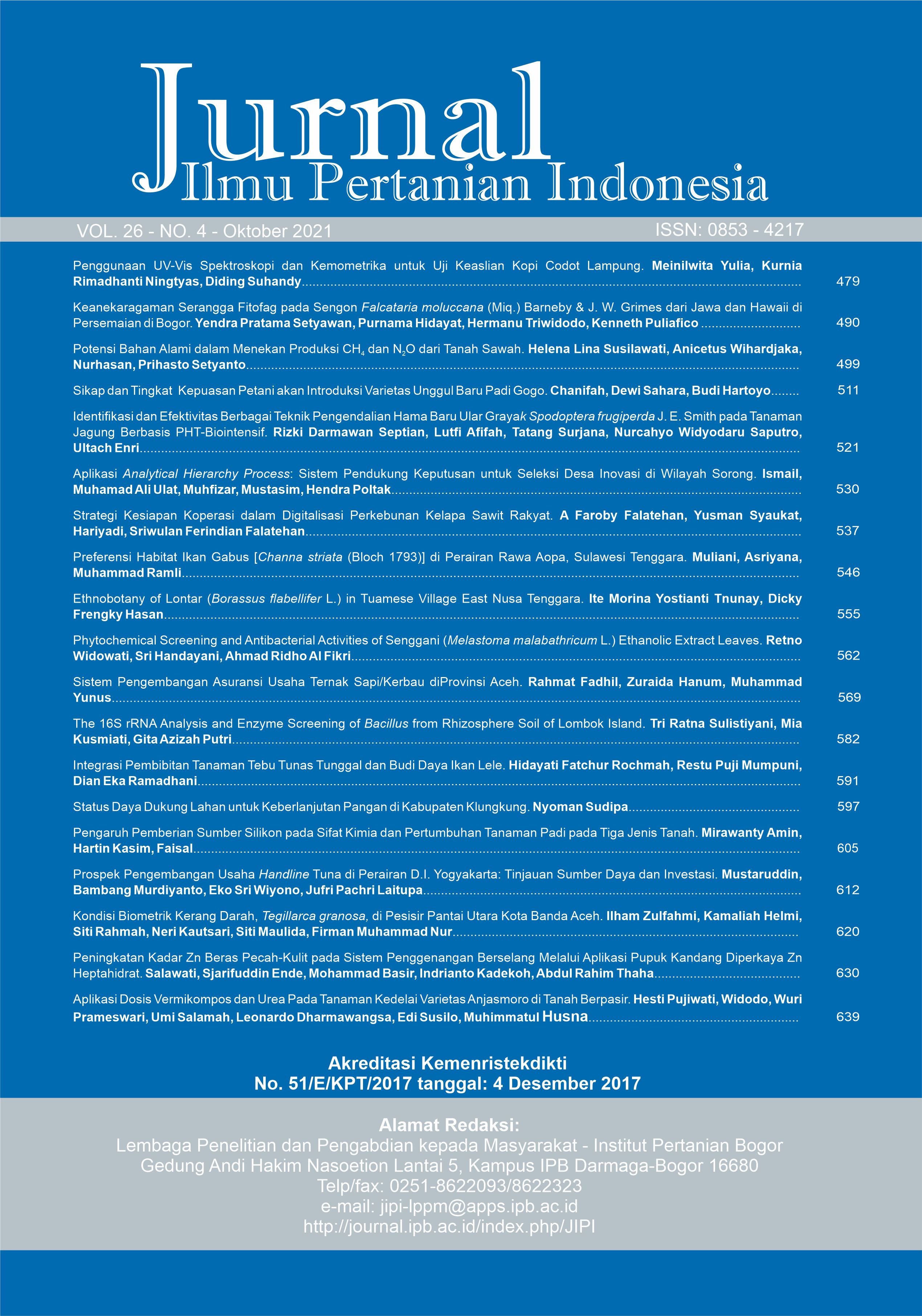Aplikasi Analytical Hierarchy Process: Sistem Pendukung Keputusan untuk Seleksi Desa Inovasi di Wilayah Sorong
Abstract
Rural-urban social inequality is a problem that must be solved to achieve prosperity and economic justice that is desired by all human beings. Efforts to overcome the problem are to create and carry out the Program of Marine and Fisheries Innovation Village which is a program of marine and fisheries community empowerment to be able to take advantage of technology and innovation as an effort to improve their lives. Limited budget and resources cause not all villages that are partners in community service at the Sorong Marine and Fisheries Polytechnic can be turned into Marine and Fisheries Innovation Villages. This research was conducted to determine the priority ranking of villages to be selected and to carry out innovation and technology interventions according to the predetermined criteria. Decision making in this marine and fisheries innovation village requires a systematic and accurate method using the Analytical Hierarchy Process (AHP). In the case study, the selection of the innovation village program was carried out at three locations in the Sorong area (Walal Village, Rimbapala Village, and Pulau Raam Village). The criteria used in the selection of alternative innovation villages were: 1) having local government support, 2) community response, 3) having superior fishery commodities, 4) accessibility, and 5) in accordance with the resources owned by the KP Sorong Polytechnic. The results obtained based on the AHP method were Raam Island 58,7%, Walal 21,9%, and Rimbapala 19,4%. The conclusion is that the village selected as the innovation village is Raam Island with the highest score of 58,7%.
Keywords: alternatives, analytical hierarchy process, criteria, innovation village, options
Downloads
References
Anwar Z, Wahyuni W. 2019. Miskin di laut yang kaya: nelayan Indonesia dan kemiskinan. Sosioreligius. 4(1).
Arifiani TA, Sjaf S. 2018. Analisis respon masyarakat terhadap pengelolaan dana desa untuk pembangunan pedesaan. Jurnal Sains Komunikasi dan Pengembangan Masyarakat. 2(3): 317-332. https://doi.org/10.29244/jskpm.2.3.31733 2
Baffoe G. 2019. Exploring the utility of analytic hierarchy process (AHP) in ranking livelihood activities for effective and sustainable rural development interventions in developing countries. Evaluation and Program Planning. 72: 197-204. https://doi.org/10.1016/j.evalprogplan.2018.10.017
Bapna M. 2012. Sustainability is key to development goals. Nature. 489(7416): 367. https://doi.org/10.10 38/489367a
Benítez J, Delgado-Galván X, Izquierdo J, Pérez-García R. (2015). Consistent completion of incomplete judgments in decision making using AHP. Journal of Computational and Applied Mathematics. 290: 412-422. https://doi.org/10.1016 /j.cam.2015.05.023
Choi JS. 2015. Improvements of efficiency of analytical hierarchy process (AHP) for project priority in International Rural Development. 한국국제농업개 발학회지. 27(1): 7-14. https://doi.org/10.12719/KSI A.2015.27.1.7
Cooper O. 2017. The magic of the analytic hierarchy process (AHP). International Journal of the Analytic Hierarchy Process. 9(3). https://doi.org/10.13033/ija hp.v9i3.519
Darmoko PD. 2015. Laporan penelitian potensi desa inovasi di Kabupaten Pemalang. Madaniyah. 5(2): 198-211.
Darwis V, Rusastra IW. 2016. Optimalisasi pemberdayaan masyarakat desa melalui sinergi program puap dengan desa mandiri pangan. Analisis Kebijakan Pertanian. 9(2): 125-142. https ://doi.org/10.21082/akp.v9n2.2011.125-142
Geurs KT, Boon W, Van Wee B. 2009. Social impacts of transport: literature review and the state of the practice of transport appraisal in the Netherlands and the United Kingdom. Transport Reviews. 29(1): 69-90. https://doi.org/10.1080/0144164080213049 0
Griggs D, Stafford-Smith M, Gaffney O, Rockström J, Öhman MC, Shyamsundar P, Steffen W, Glaser G, Kanie N, Noble I. 2013. Sustainable development goals for people and planet. Nature. 495(7441): 305-307. https://doi.org/10.1038/495305a
Imai KS, You J. 2014. Poverty dynamics of households in rural China. Oxford Bulletin of Economics and Statistics. 76(6): 898-923. https://doi.org/10.1111/o bes.12044
Kusrini K. 2007. Aplikasi Sistem Pendukung Keputusan. Yogyakarta (ID): Andi.
Ortega E, López E, Monzón A. 2014. Territorial cohesion impacts of high-speed rail under different zoning systems. Journal of Transport Geography. 34: 16-24. https://doi.org/10.1016/j.jtrangeo.2013.1 0.018
Peraturan Kepala Badan Riset dan SDM Kelautan dan Perikanan Nomor 6/Per-BRSDM/2020, 64717173 1. 2020.
Rahadi DR. 2016. Model Pengembangan Kampung sebagai Desa Inovatif (Studi Kasus Kota Palembang). FIRM Journal of Management Studies. 1(2).
Rahayu T, Krisnanik E, Hananto B. 2019. Metode Analytical Hierarchy Process Dalam Menentukan Pemilihan Desa Terbaik. Jurnal Rekayasa Sistem Dan Teknologi Informasi. 3(1): 94-99. https://doi .org/10.29207/resti.v3i1.769
Ramírez‐Rivera E de J, Morales‐Carrera UA, Limón‐Rivera R, Castillo‐Martínez SI, Hernández‐Salinas G, Ramírez‐Sucre MO, Herrera‐Corredor JA. 2020. Analytic hierarchy process as an alternative for the selection of vocabularies for sensory characterization and consumer preference. Journal of Sensory Studies. 35(1): e12547. https://doi.org /10.1111/joss.12547
Saaty TL. 2008. Decision making with the analytic hierarchy process. International Journal of Services Sciences. 1(1): 83-98. https://doi.org/10.1504/IJSS CI.2008.017590
Sugiri L. 2012. Peranan Pemerintah Daerah dalam Pemberdayaan Masyarakat. Publica. 2(1).
Todaro MP, Smith SC. 2011. Pembangunan Ekonomi. Jilid 1 Edisi 10. Jakarta (ID): Erlangga.
Tollefson J. 2015. Can randomized trials eliminate global poverty? Nature News. 524(7564): 150. https://doi.org/10.1038/524150a
Yogi M. 2019. Penerapan analytical hierarchy process dalam pengalokasian dana Desa Kecamatan Tiga Panah Kabupaten Karo. [Skripsi]. Medan (ID): Universitas Sumatera Utara.
This journal is published under the terms of the Creative Commons Attribution-NonCommercial 4.0 International License. Authors who publish with this journal agree to the following terms: Authors retain copyright and grant the journal right of first publication with the work simultaneously licensed under a Creative Commons Attribution-NonCommercial 4.0 International License. Attribution — You must give appropriate credit, provide a link to the license, and indicate if changes were made. You may do so in any reasonable manner, but not in any way that suggests the licensor endorses you or your use. NonCommercial — You may not use the material for commercial purposes.























